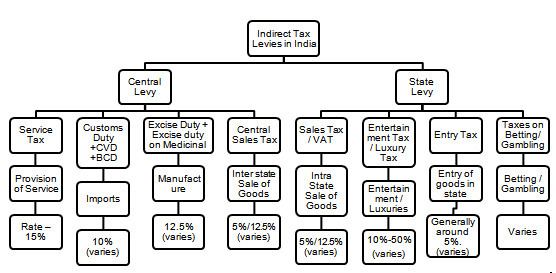 | ||
Goods and Services Tax (GST) is a proposed system of indirect taxation in India merging most of the existing taxes into single system of taxation. It was introduced as The Constitution (One Hundred and First Amendment) Act 2016. The GST is administered & governed by GST Council and it's Chairman is Union Finance Minister of India Arun Jaitley.
Contents
GST would be a comprehensive indirect tax on manufacture, sale and consumption of goods and services throughout India, to replace taxes levied by the central and state governments. The GST is consumption based tax levied on the supply of Goods and Services which means it would be levied and collected at each stage of sale or purchase of goods or services based on the input tax credit method. This method allows GST-registered businesses to claim tax credit to the value of GST they paid on purchase of goods or services as part of their normal commercial activity. Taxable goods and services are not distinguished from one another and are taxed at a single rate in a supply chain till the goods or services reach the consumer. Administrative responsibility would generally rest with a single authority to levy tax on goods and services. Exports would be considered as zero-rated supply and imports would be levied the same taxes as domestic goods and services adhering to the destination principle in addition to the Customs Duty which will not be subsumed in the GST.
The introduction of Goods and Services Tax (GST) would be a significant step in the reform of indirect taxation in India. Amalgamating several Central and State taxes into a single tax would mitigate cascading or double taxation, facilitating a common national market. The simplicity of the tax should lead to easier administration and enforcement. From the consumer point of view, the biggest advantage would be in terms of a reduction in the overall tax burden on goods, which is currently estimated at 25%-30%, free movement of goods from one state to another without stopping at state borders for hours for payment of state tax or entry tax and reduction in paperwork to a large extent.
What changes there would be if India launches GST- “The tax rate under GST may be nominal or zero rated for the time being. It has been proposed to insulate the revenues of the States from the impact of GST, with the expectation that in due course, GST will be levied on petroleum and petroleum products.” The central government has assured states of compensation for any revenue losses incurred by them from the date of introduction of GST for a period of five years.
As India is a federal republic GST would be implemented concurrently by the central government and by state governments.
History
The Constitution (One Hundred Twenty Second Amendment) Bill, 2014 proposes a national Value Added Tax to be implemented in India. The taxes which will be subsumed into GST include central excise duty, services tax, additional customs duty, surcharges and state-level value added tax. Other levies which are currently applicable on inter-state transportation of goods are also likely to be done away with in GST regime.
A 21-member select committee was formed to look into the proposed GST law.
Present Indirect structure is marked with following problems:
Presently, the Constitution empowers the Central Government to levy excise duty on manufacturing and service tax on the supply of services.
GST shall subsume the following taxes in the times to come once the law is in force:
GST will be applicable from 01 July 2017.
Legislation
The government is planning to introduce three bills for GST in the parliament in winter session 2016 viz. CGST law, IGST law and compensation law. There will be no GST on the sale and purchase of securities. That will continue to be governed by Securities Transaction Tax (STT).
Proposed regime
GST threshold was set at ₹10 lakh (US$15,000) for the north-east and hill states and ₹20 lakh (US$30,000) for other states in the first GST council meet. Centre and states agreed that assessee up to ₹1.5 crore (US$220,000) will be assessed by states and above that will be assessed by centre and states.
As per the decisions made by all will of GST Council on November 3, 2016, tax rates would be at 4 slabs of 5%, 12%, 18% and 28%. Luxury and demerit goods will be taxed at 28% plus cess. daily needs will be taxed at 5%.
GSTN
Goods and Services Tax Network (GSTN) is a not-for-profit, non-government firm that would provide IT infrastructure and services to the central and state governments, taxpayers and other stakeholders for implementation of the Goods and Services Tax (GST). It will be owned by three stakeholders—the centre, the states and the technology partner NSDL, the then Central Board of Excise and Customs (CBEC) Chairman S. Dutt Majumdar said while addressing a "National Conference on GST". On the possibility of rolling out GST, he said, "There was no need for alarm if GST was not rolled out in April 1, 2017".
Migration of the existing taxpayers to GST regime
All the existing taxpayers registered under VAT, Service Tax, and Excise are required to furnish the details at GST Common portal for the purpose of migrating themselves into GST regime. To begin with, the taxpayers registered under the State Vat Department needs to provide their details and period for furnishing these details are specified for every state.Once the taxpayers provide their details there will be no need for them to register again with the State or Center once the GST Act is implemented. Enrollment process for other existing taxpayers not registered with VAT will be started at a later date.
